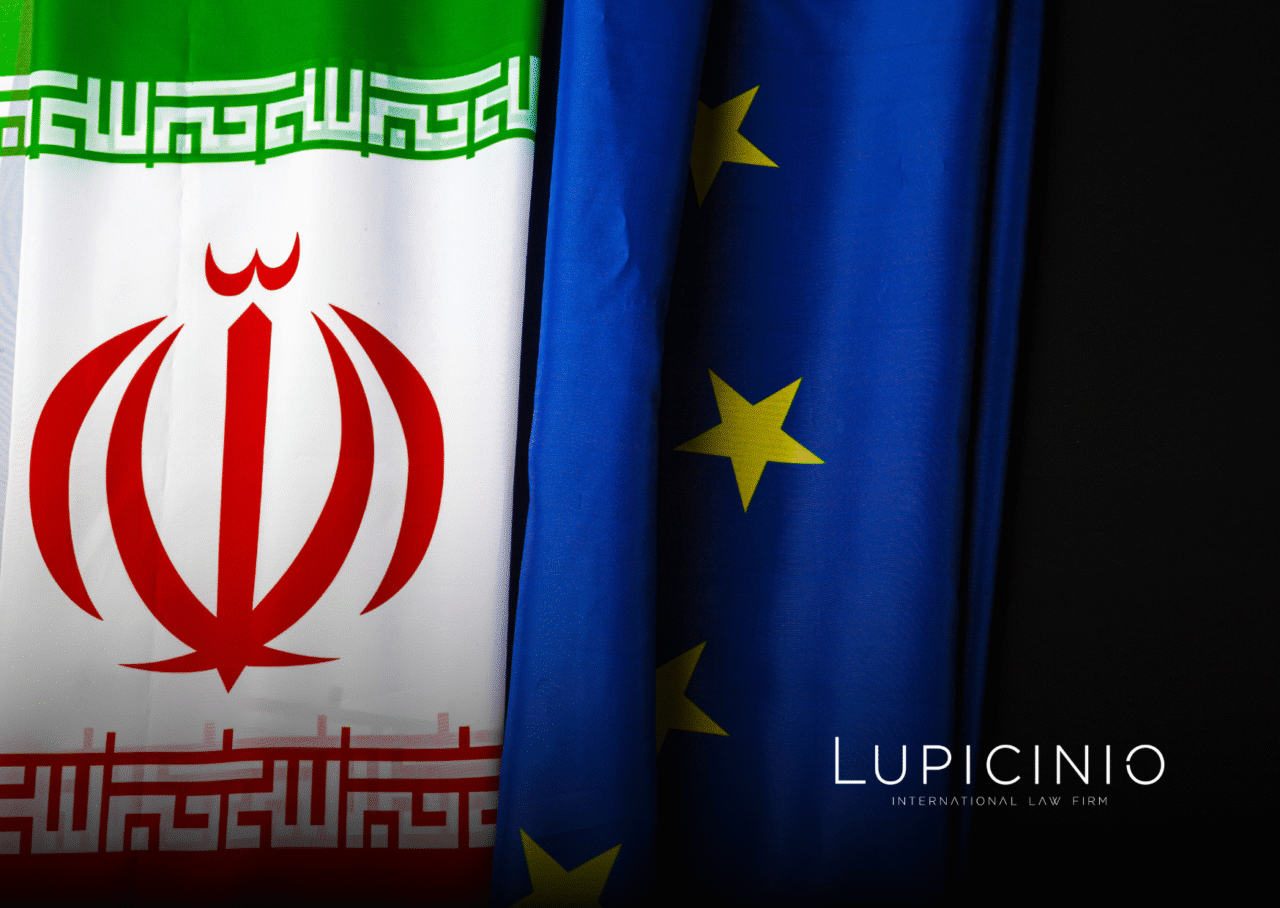On 29 September 2025, the European Union published a comprehensive regulatory package in the OJEU that immediately reinstates nuclear sanctions against Iran, which had been suspended since 2016 following the PAIC/JCPOA nuclear agreement. This reactivation is taking place through the automatic “snap-back” mechanism provided for in that agreement, following formal activation by Germany, France and the United Kingdom on 28 August 2025 before the UN Security Council.
Immediate impact: All prohibitions and restrictions on trade, maritime transport, energy, nuclear technology, strategic metals and, in particular, financial transactions with Iran are reinstated. Hundreds of natural and legal persons (state entities, banks, shipping companies, energy companies) are back on the sanctions lists with immediate effect.
Action required: Urgent review of all commercial, financial and logistical relationships with Iranian counterparties, including comprehensive screening of customers, suppliers, final beneficiaries, vessels and intermediary entities.
Tabla de contenidos
1. Context and Legal Basis
1.1. Activation of the “snap-back” mechanism.
The Joint Comprehensive Plan of Action (JCPOA), signed in 2015, established an automatic mechanism for reintroducing sanctions in the event of significant non-compliance by Iran. On 28 August 2025, the foreign ministers of Germany, France and the United Kingdom (E3) formally notified the UN Security Council (UNSC) of the activation of this mechanism.
After 30 days without the adoption of a continuity resolution, on 27 September 2025, UNSC resolutions 1696 (2006), 1737 (2006), 1747 (2007), 1803 (2008), 1835 (2008) and 1929 (2010) were automatically reactivated.
1.2. Coordinated response by the EU.
In line with its 2015 Declaration, the European Union proceeded to reintroduce its own restrictive measures in a synchronised manner on 29 September 2025, through a regulatory package consisting of:
- Three Common Foreign and Security Policy (CFSP) Decisions.
- Three Regulations directly applicable in all Member States.
This set of regulations fully restores the pre-PAIC sanctions framework, updating lists and strengthening prohibitions in critical sectors.
2. Regulatory Architecture of the Package
2.1. Policy framework: CFSP Decisions.
A) Implementing Decision (CFSP) 2025/1971.
Function: Operationally updates Annexes I and II of Decision 2010/413/CFSP to synchronise the lists with the UN snap-back and reactivate designations.
B) Decision (CFSP) 2025/1972.
Function (structural reform):
- Reorganises the governance of the lists, clearly distinguishing between designations derived from UN resolutions (Annex I) and autonomous EU designations (Annex II).
- It repeals the transitional articles of the PAIC period (Articles 26a to 26g and Annexes III-VI).
- It maintains only a limited suspension for Ali Akbar Salehi (former president of the AEOI).
- Critical element: Introduces contractual continuity clauses until 1 January 2026 for contracts concluded before 30 September 2025 in certain areas, under strict conditions.
C) Decision (CFSP) 2025/1978.
Function: Massive revision of Annex II (autonomous EU list) with:
- Update of high-level individuals linked to the nuclear/missile programme.
- Reinstatement of entities in the energy, maritime and financial sectors.
- Deletion of certain obsolete entries.
2.2. Executive framework: Directly applicable regulations.
D) Regulation (EU) 2025/1975.
Main instrument: Amends Regulation (EU) 267/2012 (parent regulation on sanctions against Iran) by reinstating all prohibitions on:
- Trade in sensitive goods and technologies (including strategic metals and dual-use software).
- Financial transfers and the provision of funds.
- Energy sector (oil, gas, petrochemicals).
- Maritime transport and auxiliary services.
- Investments and financial services.
Legal certainty clause: Establishes that there is no retroactivity for contracts entered into before 30 September 2025, allowing their execution until 1 January 2026 under conditions of compatibility with the PAIC and the re-established provisions.
3. High-Risk Sectores and Entities
3.1. Financial system.
Re-designated:
- Bank Melli Iran (including its entire international network).
- Central Bank of Iran (CBI)
- Bank Tejarat (financing of state energy and petrochemical projects).
- Related investment funds (First Persian Equity Fund).
Consequence: Absolute prohibition on transactions, opening/maintaining correspondent accounts, providing financial services and SWIFT transfers.
3.2. Maritime transport and logistics.
Critical entities relisted:
- IRISL (Islamic Republic of Iran Shipping Lines) and its entire ecosystem.
- South Way Shipping Agency (owned/controlled by IRISL and the Iranian Government).
- Valfajr 8th Shipping Line.
- IRISL Benelux NV.
- Irano Hind Shipping Company.
- South Shipping Line Iran (SSL).
- Port agencies in Special Economic Zones.
Operational impact: Prohibition of chartering, port services, marine insurance, ship reclassification and shipping agency services.
3.3. Energy sector.
Extensive redesignations:
- NIOC (National Iranian Oil Company) and its constellation of subsidiaries.
- State-linked petrochemical companies.
- Oil and gas projects financed by state banks.
Restrictions: Prohibition on the supply of technology, equipment, investments, joint ventures and the provision of specialised technical services.
3.4. Nuclear programme and dual-use entities.
Reactivated organisations:
- AEOI (Atomic Energy Organisation of Iran) – parent organisation.
- FATSA and other nuclear fuel cycle entities.
- Dual-use engineering and technology companies.
- Suppliers of strategic metals and sensitive software.
3.5. Military-industrial complex.
IRGC/CGRI entities:
- Khatam al-Anbiya (KAA) and its multiple contractors/subsidiaries (Sepasad, Sepanir and Sahel Consultant Engineers).
- Construction, infrastructure and logistics companies controlled by the IRGC.
4. Immediate compliance Obligations
4.1. Freezing of assets and funds.
Direct application: All funds and economic resources belonging to, owned, held or controlled by persons/entities listed in Annexes VIII and IX shall be frozen immediately.
Prohibition on making funds available: It is expressly prohibited to make funds or economic resources, directly or indirectly, available to those listed, including:
- Bank transfers.
- Payment of outstanding invoices.
- Release of guarantees.
- Refunds or returns.
- Any financial benefit.
Notification obligation: Any entity that identifies frozen assets must immediately notify the competent national authority.
4.2. Trade and service prohibitions.
- Sale, supply, transfer or export of goods and technologies included in the technical annexes.
- Provision of technical, financial, insurance, reinsurance or brokerage services related to the prohibited sectors.
- Investments in the energy, petrochemical and critical infrastructure sectors.
- Flagging, classification, certification and inspection services to Iranian vessels or vessels controlled by listed entities.
4.3. Enhanced Due Diligence.
Mandatory screening against consolidated lists:
- Annex VIII (UN) of Regulation 267/2012.
- Annex IX (EU) to Regulation 267/2012.
- Annex II to Decision CFSP 2010/413 (amended by 1978).
Elements to be verified:
- Full legal name and known aliases.
- Identifiers: BIC/SWIFT, registration codes, IMO numbers (ships), addresses, websites.
- Chain of ownership and control (Ultimate Beneficial Owners – UBOs).
- Indirect business relationships through subsidiaries, agents, intermediaries.
Recommended tools:
- UN sanctions databases, OFAC (US), OFSI (UK).
5. Transitional Regime: Pre-Existing Contracts
5.1. Principle of limited non-retroactivity.
The regulatory package establishes that the reinstated prohibitions are not retroactive for contracts entered into before 30 September 2025, provided that they meet strict conditions.
5.2. Window of enforcement.
Pre-existing contracts may be performed until 1 January 2026 in the following cases:
- Energy transactions (oil, gas).
- Investments in progress.
- Infrastructure projects.
- Certain ancillary financial services.
5.3. Conditions of validity.
To qualify for the transitional regime, it is essential to provide:
- Documentary proof that the contract was concluded before 30 September 2025.
- Material compatibility with the obligations of the PAIC and the reinstated provisions.
- Absence of elements expressly prohibited and excluded from the transitional regime.
- Case-by-case legal analysis with specialist advice.
Exclusions from the transitional regime.
The following do not benefit from the transitional window:
- Contracts with entities designated for supporting nuclear proliferation or terrorism.
- Transactions related to ballistic missile programmes.
- Transactions with the IRGC/CGRI or Khatam al-Anbiya.
- Supply of goods/technologies from the most sensitive technical lists.
6. Immediate Action Plan
PHASE 1: INVENTORY AND ASSESSMENT (Deadline: 48-72 hours).
Responsible parties: Compliance, Legal, Operations, Finance.
Actions:
- Exhaustive identification of all commercial, financial or logistical relationships with direct Iranian counterparties, intermediaries, agents, distributors operating with/from Iran, Iranian-flagged vessels or vessels managed by Iranian entities, and operations in Iranian ports or Special Economic Zones.
- Complete screening against updated consolidated lists (Annexes VIII, IX, Annex II CFSP).
- Review of contractual portfolio: current contracts with date of signature, outstanding obligations, outstanding payments (issued and receivable), active bank guarantees, open letters of credit.
- Identification of financial exposures: accounts opened in/for Iranian entities, scheduled transfers, active credit lines, investments in funds or projects with Iranian exposure.
PHASE 2: RISK MANAGEMENT AND BLOCKING (Immediate).
Responsible parties: Compliance, Finance, Legal.
Actions:
- Preventive blocking of all identified transactions until legal analysis is complete.
- Immediate freezing of funds/assets related to listed entities.
- Notification to competent authorities of identified frozen assets.
- Precautionary suspension of pending payments, scheduled shipments and ongoing services.
PHASE 3: LEGAL ANALYSIS AND RESTRUCTURING (5-10 days).
Responsible parties: Legal (external/internal), Compliance.
Actions:
- Detailed assessment of pre-existing contracts to determine eligibility for transitional regime, feasibility of execution until 01-01-2026 and residual risks of non-compliance.
- Mitigation strategies: restructuring of operations to eliminate exposure to listed entities, search for alternative counterparties, renegotiation or early termination of contracts.
- Request for regulatory clarifications from competent authorities for complex cases.
PHASE 4: INTERNAL AND EXTERNAL COMMUNICATION (Immediate and ongoing).
Responsible parties: Compliance, Corporate Communications, Management.
Internal actions:
- Urgent circular to all operational areas informing them of the reinstatement of sanctions.
- Specific training for front-office teams (sales, commercial, operations).
- Update internal compliance policies and procedures.
- Reinforcement of automatic alerts in screening systems.
External communications:
- Formal notification to customers, suppliers, and business partners about the new regulatory framework.
- Coordination with correspondent banks, insurers, shipping companies and brokers.
- Updating of standard contractual clauses to incorporate provisions for enhanced penalties.
PHASE 5: CONTINUOUS MONITORING (Ongoing).
Responsible parties: Compliance.
Actions:
- Subscription to official alerts for list updates (EU, UN, US, UK).
- Periodic (weekly) review of consolidated lists.
- Recurring screening of active customer/supplier portfolio.
- Quarterly audits of sanctions compliance.
7. International Coordination
7.1. United Kingdom.
The United Kingdom has adopted equivalent measures in a coordinated manner. Companies with operations in the UK must verify compliance with the updated UK Sanctions List and OFSI (Office of Financial Sanctions Implementation) regulations.
7.2. United States.
Although the US never lifted its sanctions against Iran, it is likely to strengthen its enforcement and coordination with allies. Companies should consider the impact of OFAC secondary sanctions, restrictions on USD transactions, and the risk of listing for violation of EU/UN sanctions.
8. Consequences of Non-Compliance
8.1. Administrative sanctions.
- Administrative sanctions are established by each Member State in accordance with the principles of effectiveness, proportionality and deterrence .
- Revocation of operating licences.
- Prohibition from participating in public procurement.
8.2 Criminal penalties
Criminal penalties are established by each Member State in accordance with the principles of effectiveness, proportionality and dissuasiveness. They are being harmonised throughout the European Union as Member States transpose Directive 2024/1226.
With the collaboration of José Luis Iriarte, Professor of Private International Law at the Universidad Pública de Navarra.
******
More information:
Lupicinio International Law Firm
C/ Villanueva 29
28001 Madrid
P: +34 91 436 00 90







